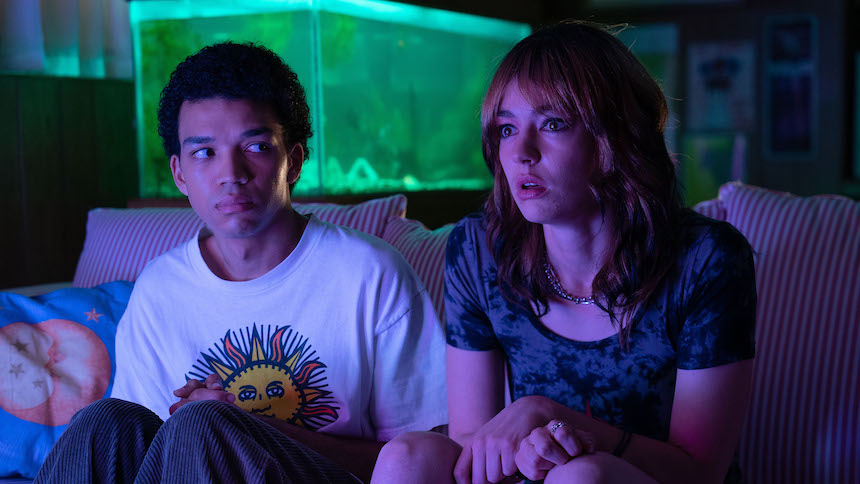Sundance 2024 Review: I SAW THE TV GLOW, Enthralling Exploration of Cult Fandoms, Nostalgia, and Trans Identity

In writer-director Jane Schoenbrun’s (We're All Going to the World's Fair) second feature-length film, I Saw the TV Glow, cult fandoms, the positives and perils inherent in nostalgia (tonic or toxin), and the boundless search for personal identity, specifically trans identity refracted through media consumption and social norms, come together in Voltron-like fashion into a disquieting, discomfiting blend of fantasy, horror, and drama.
Riddled with existential discomfort, surreal digressions, and fractured, irreparable identities, I Saw the TV Glow confirms Schoenbrun’s status as a singularly talented, risk-embracing filmmaker more than worthy of the accolades and acclaim that have come their way.
To anyone who counts the 90s as a formative period in their lives, fandoms, specifically cult fandoms, weren’t anything new (e.g., Star Trek: The Original Series), just intensified with the advent of serialized television shows like The X-Files and Buffy, the Vampire Slayer. Both programs depended on a combination of overarching, mythology-driven episodes with so-called 'monsters-of-the-week.'
With reruns or VHS the only alternatives for viewers to catch up on missed episodes, watching either show when they premiered became the equivalent of appointment television, seen with friends and families in person, discussed the next day with like-minded classmates or co-workers.
So too for The Pink Opaque, the intriguing show-within-the-film at the unstable center of I Saw the TV Glow. A late-night, young-adult show airing exclusively on Saturday nights on basic cable, The Pink Opaque focuses on two teens, Isabel (Helena Howard) and Tara (Lindsey Jordan), each gifted with psychic powers, as they fight the obligatory monsters of the week and the series’s big bad, Mr. Melancholy. Separated by geographical distance, the psychic friends communicate via astral projection, meeting in person only twice, during the pilot and final episodes, respectively.
For Owen (Ian Foreman as a preteen, Justice Smith as a teen and adult), The Pink Opaque represents a tantalizingly forbidden and thus, desirable experience. Airing too late to watch without his parents' permission, Owen learns of the show's existence second-hand via TV ads or the well-worn episode guide he spots in the hands of an older Goth classmate, Maddy (Brigette Lundy-Paine), one day after school. Naturally attracted by Maddy’s punkish, isolationist attitude and drawn to the secret pleasures The Pink Opaque promises, Owen all but invites himself to Saturday night sleepovers at Maddy’s place.
Lying to his parents becomes the first, but not the last, transgression Owen commits on a halting journey toward self-realization, but it’s not the last. Nor is it Maddy’s, a desperately unhappy teen who dreams of leaving the stifling, suffocating confines of suburbia behind for parts unknown. At least in part, Maddy broadly represents teen outsiders everywhere and every-when, imagining themselves living better, more fulfilling, ultimately more authentically lives somewhere else.
The profoundly unhappy Maddy projects her dreams and desires into The Pink Opaque, seeing it as more than a late-night TV show for young adults: it’s a kind of Biblical text, almost endlessly malleable, its hidden secrets available to searchers like Maddy and later Owen with the intelligence, foresight, and willingness to see beyond the surface text to the meanings and messages below. All they have to do is look, truly look with a perception available only to a few, the world’s maddening complexities and contradictions will become clearer, and a way out will present itself.
Schoenbrun deliberately leaves Maddy’s question about the nature of reality, specifically their shared reality and whether a second, more “real” reality lies underneath or next to Maddy and Owen’s, unanswered, resulting in a third act that ends not with catharsis, but anti-catharsis. In the grip of cult-like obsession, Maddy urges Owen to trust her without qualification, take a leap of faith, and find his — or rather their — true self.
Owen, however, seems incapable of choosing the riskier, potentially more dangerous, option. Driven by personal fears and anxieties, the risk-averse Owen’s life choices leave him first trapped and then buried by social and cultural conformity.
I Saw the TV Glow premiered at the Sundance Film Festival. A24 will distribute it later this year.
I Saw the TV Glow
Director(s)
- Jane Schoenbrun
Writer(s)
- Jane Schoenbrun
Cast
- Justice Smith
- Brigette Lundy-Paine
- Ian Foreman







